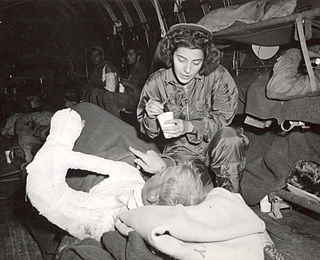


The Flight Nurse Badge is a military badge of the United States armed forces which is issued by the U.S. Air Force and United States Navy to flight nurses. Versions of this badge have existed since World War II, when the decoration was first created as the Army Air Forces Flight Nurse Badge. [1] [2] [3]

Military badges of the United States are awards authorized by the United States Armed Forces that signify rating, qualification, or accomplishment in several career fields, and also serve as identification devices for personnel occupying certain assignments. Personal recognition is granted to service members by a number of awards and decorations. Together with military decorations, such badges are authorized for wear on military uniforms.

The United States Air Force (USAF) is the aerial and space warfare service branch of the United States Armed Forces. It is one of the five branches of the United States Armed Forces, and one of the seven American uniformed services. Initially formed as a part of the United States Army on 1 August 1907, the USAF was established as a separate branch of the U.S. Armed Forces on 18 September 1947 with the passing of the National Security Act of 1947. It is the youngest branch of the U.S. Armed Forces, and the fourth in order of precedence. The USAF is the largest and most technologically advanced air force in the world. The Air Force articulates its core missions as air and space superiority, global integrated intelligence, surveillance, and reconnaissance, rapid global mobility, global strike, and command and control.

The United States Navy Nurse Corps was officially established by Congress in 1908; however, unofficially, women had been working as nurses aboard Navy ships and in Navy hospitals for nearly 100 years. The Corps was all-female until 1965.
The Flight Nurse Badge is issued in two different versions, one for the Navy and the other for the Air Force. To be awarded the Flight Nurse Badge, a service member must be a commissioned officer and a Registered Nurse and must also complete training normally befitting the award of the Aircrew Badge. Upon completion of prerequisite training, a service member must complete advanced studies in Aerospace Medicine and be qualified as a military flight nurse. The Flight Nurse Badge is then presented after a probationary period of in-flight instruction and observation.[ citation needed ]
The Aircrew Badge, commonly known as Wings, is a qualification badge of the United States military that is awarded by all five branches of armed services to personnel who serve as aircrew members on board military aircraft. The badge is intended to recognize the training and qualifications required by aircrew of military aircraft. In order to qualify as an aircrew member and receive the Aircrew Badge, such personnel typically undergo advanced training in aircraft in-flight support roles.
The Air Force version of the Flight Nurse Badge is issued in three degrees: Basic, Senior, and Master. The Basic Flight Nurse Badge is awarded upon completion of all training and qualification as a flight nurse. The Senior and Master versions of the Flight Nurse Badge are awarded based on years of service in the Air Force and number of flight hours obtained. The different degrees of the Flight Nurse Badge are denoted by a star (Senior level) or a star with wreath (Master level) centered above the decoration. [1]
The United States Navy issues the Flight Nurse Badge in a single degree. None of the other military branches maintains an equivalent to the Flight Nurse Badge. The decoration is similar to the Flight Surgeon Badge. [2]











